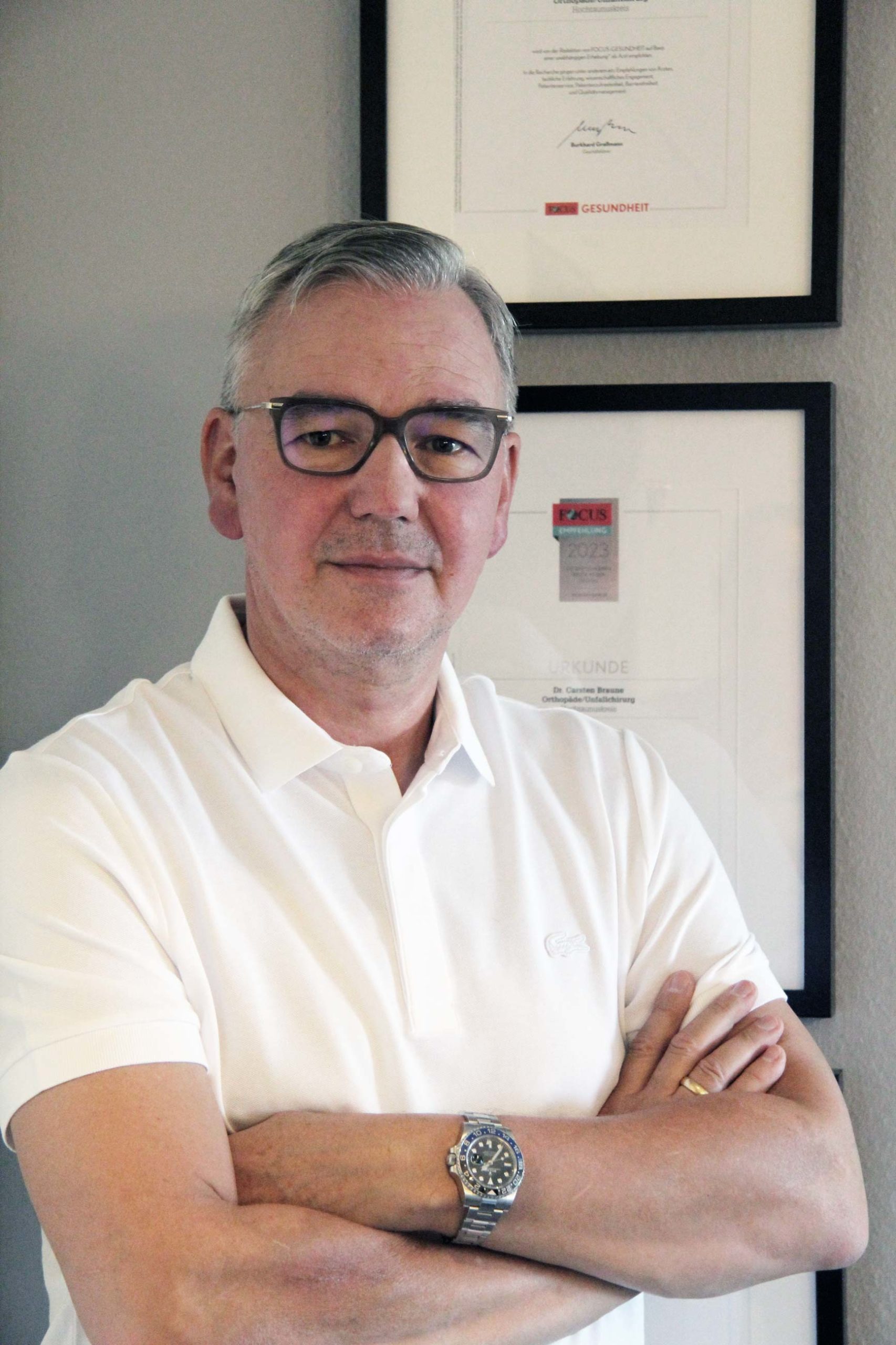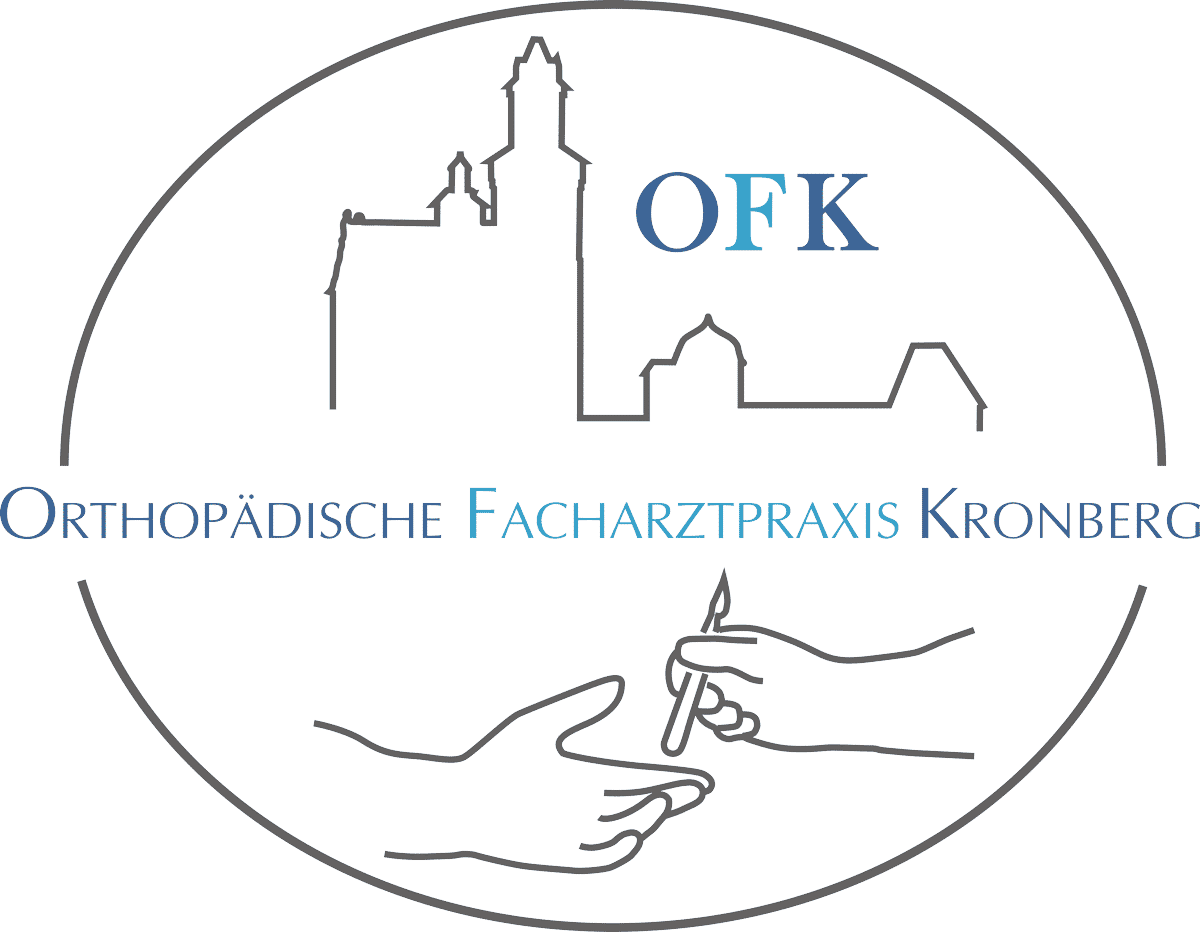Calcareous shoulder
When calcium deposits in the shoulder make life difficult
Pain in the shoulder can have a variety of causes. One of these is calcific shoulder, also known as tendinosis calcarea (from "tendo" = "tendon" and "calcarea" = "calcareous"). In calcific shoulder, calcium deposits form in the tendons of the so-called rotator cuff. If these calcium deposits increase in size, they initially cause movement-dependent pain. In the course of time, this pain can also occur without strain and may disappear completely in the meantime.
Thanks to state-of-the-art diagnostics, Dr. Braune recommends individual treatment strategies to his patients and , as an experienced orthopaedic surgeon, is able to perform surgical procedures.
With the help of a shoulder examination and imaging procedures such as X-rays or ultrasound examinations, the calcium deposits can be visualized and a diagnosis of calcific shoulder can be made. Various conservative and interventional forms of treatment can be used to alleviate the symptoms of calcified shoulder. An established procedure for removing calcium deposits is so-called shock wave therapy or arthroscopic calcium depot removal. This and other therapeutic procedures are routinely offered at Dr. Braune's practice.
Definition
What exactly is a calcified shoulder and what causes it?
Calcified shoulder (lat. tendinosis calcarea) is a disease of the shoulder in which calcium deposits occur in the tendons of the rotator cuff. The rotator cuff is a group of four shoulder muscles that are responsible for stabilization and certain movements of the shoulder, among other things. The supraspinatus tendon is most frequently affected (in over 90% of cases). This runs below the acromion (roof of the shoulder). This is important because calcifications can cause the space below the acromion to narrow significantly, which can lead to the tendon or bursa becoming trapped (impingement syndrome).
The cause and trigger of the clinical picture of calcification in the muscle cuff covering the humeral head (rotator cuff) is not yet known.
What symptoms does a calcified shoulder cause?
Calcified shoulder disease is a cyclical, self-limiting clinical picture that progresses in three stages that follow one another in time. Stagnation or regression of the calcification with symptom-free intervals is also possible.
The disease leads to the formation of hydroxylappatite crystals in the tendon tissue, which then form a calcium deposit. Once the calcium deposit is fully formed, there is a dull feeling of pressure and pain and the calcium can lead to painful inflammation and functional limitations of the tendons.
This can also lead to a secondary shoulder tendinosis caused by the calcium deposit, which often triggers impingement syndrome. As such calcium deposits do not normally occur in tendons, the immune system tries to break them down. This causes the tendons to become more inflamed, which worsens the symptoms. Ultimately, in many patients (approx. 70% of patients), the calcium deposit is eventually cleared by the immune system and the tendon can recover. Early diagnosis and treatment of calcific tendinitis is important to prevent inflammatory reactions from becoming too severe and to alleviate the symptoms.
Make an appointment online now
Therapy
How can a calcific shoulder be successfully treated?
If calcium deposits have formed in one of the tendons of the rotator cuff, there are various ways to treat them.
The first aim of therapy should be to improve the symptoms. The following treatment options are available for this:
- Cooling and protecting the shoulder
- Pain therapy (with so-called non-steroidal anti-inflammatory drugs, e.g. ibuprofen or diclofenac)
- Physiotherapy (stretching and strengthening exercises for the shoulder)
Methods for alleviating the symptoms of a calcific shoulder
In the case of acute symptoms, it is initially important to take it easy and relieve the pain. For this purpose, the shoulder is relieved with special bandages (e.g. Gilchrist bandage). Pain therapy with ibuprofen or diclofenac (so-called NSAIDs) is used to relieve the pain as well as for anti-inflammatory therapy. Additional cooling of the shoulder can alleviate inflammatory reactions and swelling.
Physiotherapy is a key procedure in the treatment of calcific shoulder in order to ensure that the shoulder is able to bear weight in the long term and to prevent further injuries. Exercises to strengthen and stretch the shoulder muscles are practiced under supervision. It is important for successful physiotherapy treatment that these exercises are then carried out regularly at home.
Imaging procedures to determine the appropriate therapy
For the second step of therapy, it is essential to assess in advance where the calcium deposits are located in the tendon and how large they are. This is done with the help of imaging procedures such as X-ray or ultrasound examinations. This makes it possible to assess which procedure is suitable for removing or dissolving the calcium deposits.
Make an appointment online now
The options for removing limescale are:
- Focused extracorporeal shock wave therapy
- Arthroscopic calcium depot removal
- Focused extracorporeal shock wave therapy can be used to treat smaller calcium deposits in particular. In this procedure, which was originally used to break up kidney stones, sound pressure waves are generated which are bundled (focused) in the depth of the tissue. The calcium deposits are gradually pulverized by the permanent, rhythmic sound pressure and shattered into smaller pieces. These smaller pieces are much easier for the body to break down. The calcium usually dissolves completely after 4-6 weeks. Depending on the findings, several sessions may be necessary. Another positive effect of shock wave therapy is pain relief, which also has a positive effect on the course of the disease.
- If conservative therapy does not improve the symptoms or if the calcium deposits cannot be dissolved using shock wave therapy, arthroscopic calcium depot removal using arthroscopy is an option. This involves inserting a camera and another instrument into the joint cavity through small incisions in the joint capsule of the shoulder in order to manually remove the calcium from the tendon.
Opportunities & Risks
What are the chances of a therapy that removes the calcium deposit? What are the risks?
Extracorporeal shock wave therapy is a very low-risk procedure for treating calcific shoulder. This method often dissolves the calcium deposits and the shoulder can be moved without pain after a few weeks.
If the symptoms of tendinosis calcarea cannot be sufficiently alleviated by conservative treatment measures, a minor surgical procedure can alleviate the symptoms in most cases or even restore complete freedom from symptoms. The calcium causing the symptoms is removed and can no longer trigger painful inflammatory reactions.
Despite all the precautions and experience of the surgeon, complications can occur during the operation. Injuries to the tendon to be operated on or other structures, bleeding and infections of the joint can be possible complications of the operation.
However, the probability of this is rather low due to the minimally invasive surgical technique (i.e. performed with the least possible injury).
Preparation & Follow-up
Can I prepare for an operation? Are there certain things to consider after the operation?
Arthroscopic calcium depot removal is usually a minor procedure that can be performed on an outpatient basis. This means that you can be picked up from hospital by an accompanying person on the day of the operation. Before the procedure, the surgeon will have an informative discussion with you about the procedure and the possible risks. The anesthetist (anesthetist) will also talk to you about the procedure and types of anesthesia, as well as their side effects.
It is important to remain fasting on the day of the operation. This means not consuming any food or drink other than a glass of water to prevent complications during anesthesia.
Immediately after the operation, the shoulder should initially be cooled and rested. It is also advisable to take painkillers (e.g. ibuprofen or diclofenac) to relieve the pain that occurs after such an operation. These also reduce the inflammatory reaction and swelling after arthroscopy.
It is important that you then undergo gradually increasing physiotherapy adapted to the pain. This should begin after the operation and, if possible, should be arranged before the operation date. Ideally, physiotherapy and shoulder exercises should also be practiced at home before the operation. In this way, a reserve of strength can be built up in the shoulder joint, which makes post-operative treatment easier.
Make an appointment online now
Schedule after the operation
- After about a week you can resume normal everyday activities (cooking, shopping etc.) with the affected side.
- When you can return to work depends on your job description. It usually takes about two to three weeks before you can return to work.
- Sporting activities should only be resumed after consultation with your doctor or when you are fully fit and pain-free.
Post-operative examinations and the removal of stitches from the 7th to 10th day after the operation can be carried out in our practice. Appointments for this will be arranged with you in advance.
If you develop a fever or notice redness on the surgical wound in the first two weeks after the operation, please call our practice immediately.
To clarify specific questions about calcified shoulder and the various treatment options, you can consult Dr. Braune and his team.



